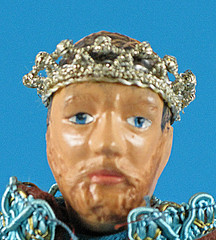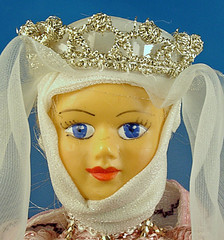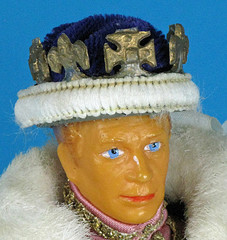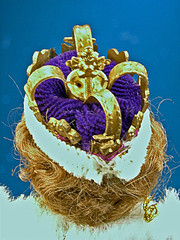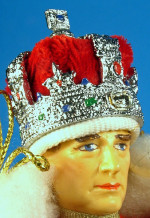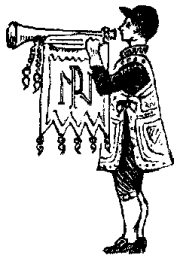Crowns
The Crown is the traditional symbolic form of headgear worn by a monarch. Strictly speaking, a Crown is only ever worn by an Emperor or Empress, King or Queen. Their styles, construction, and decoration can be many and varied, a situation echoed in the regal headgear worn by Nisbet dolls made to represent various monarchs through the ages.
Some examples are shown here :
The Wire Crown
The two pictures above are particularly interesting to the collector, because they show both the resin Tower Walk doll, (on the left), and the Styrene Historical series doll (on the right) of H/214, Queen Elizabeth I, (daughter of Henry VIII and Anne Boleyn). what is even more relevant, is that they both have the same crown, seen rather more clearly in the right hand picture. (the younger of the two dolls).
Constructed of square section wire, (which in itself is unusual, because most wire has a round section), the crowns have an intricate formation of loops and shapes intended to represent the Fleur-de-lys, cruciform decoration, and crennelations often seen on such regal items. They are also decorated with faux gems and pearls, and the wire would originally have had a gold colour.
We know the Tower Walk doll dates from 1956/1958; The wire crown provides a time-line continuity that allows us to estimate the approximate date for the Historical doll to between 1958 and 1960
The Rubber Crown
The two images above show H/214 Queen Elizabeth I, wearing a small rubber crown. This same crown, is sometimes seen on very early versions of P/610, Queen Victoria as a Widow.
The beautiful picture above is of Barbara T's stunning early Queen Elizabeth I, which as you can see, is in immaculate condition. She is included here, because she also has the small rubber crown. See a picture of the doll, showing the rest of her pristine costume, in the "Historical" dolls gallery, here :
The Rubber Coronet
The image to the left shows BR/319, Peeress of the Realm. She is not in fact wearing a crown, but a coronet, which is defined as a small crown that differs from a true crown in that it never has arches. The Peeress's coronet shown here is surmounted with six "pearls", showing that her rank is that of a Baroness).
Rubber crowns and coronets were only found on a relatively few dolls, and were probably only used between 1957 or 1958, and 1962.
Because rubber is an organic material which oxidises and breaks down over time, and the crowns and coronets are of relatively thin section, they are not always good survivors, if poorly stored, or subjected to mechanical damage.
The Lace Crown
The pictures above show how lace was used to create a crown, and this was sometimes supported with a clear plastic acetate stiffener, visible by its reflection in the crowns worn by three of the dolls in the pictures above (Top left is the unsupported (and slightly floppy) lace crown). Peggy Nisbet used a huge variety of lace trimmings, (some very expensive), on her dolls, and they were often used to simulate a crown, so you might well come across a version not shown here
The Plastic Crown
The four crowns shown above are made of painted plastic, and are all identical. They were cut to length, stitched into a circular shape, and sewn onto the hair with loops of thread. The crowns on the lower two dolls have been decorated with white overstitching.
The crown on the bottom right has four arches and a central cross feature. Look closely at the other three crowns, and you will be able to see where the arches have been cut away from the top of the four crosses (on the front,back and sides of the crown)
The two images above show a plated plastic crown, which does initially look as if it were made of pressed metal. In fact, the plastic has been electroplated so that its smooth surface appears to be metallic, because of its lustrous shine. The plastic strip was clipped to length, then tacked to the doll's hair or headdress, to form a crown.
The Metal Crown
Here we see a pressed metal crown used in three different ways - The dolls in the top two pictures have small Rhinestones glued into the circular dimples of their crowns, (not easy to see in these small photographs); the doll in the bottom left hand picture has the same metal crown incorporated as part of a headdress, and King Charles I, (bottom right) has the bare metal alone used to form his crown
This picture shows King Ralph, (see "The Dolls that Never Were") wearing a cast metal, plated and painted crown, lined with a velvet cap, usually Imperial Purple or blue, but in this case, scarlet, for this particular model. This crown, (with a purple lining), is a direct replacement for the plastic crown worn by King George VI (see above).
The collector should know that because this crown was introduced in February 1979, any doll wearing it must date from that year, or later.
There are likely to be a number of variants of the crown that we have not covered in this section, but if you discover any serious errors or omissions, we would appreciate your input!







